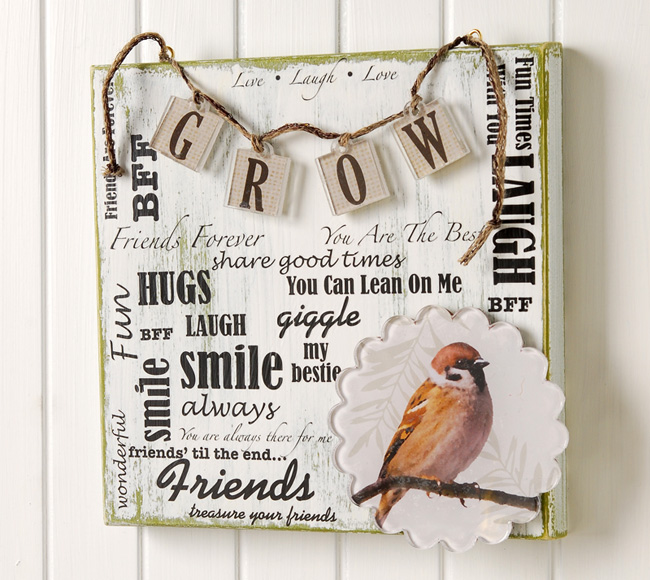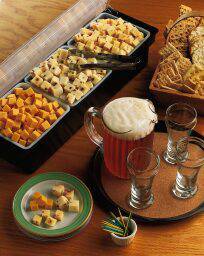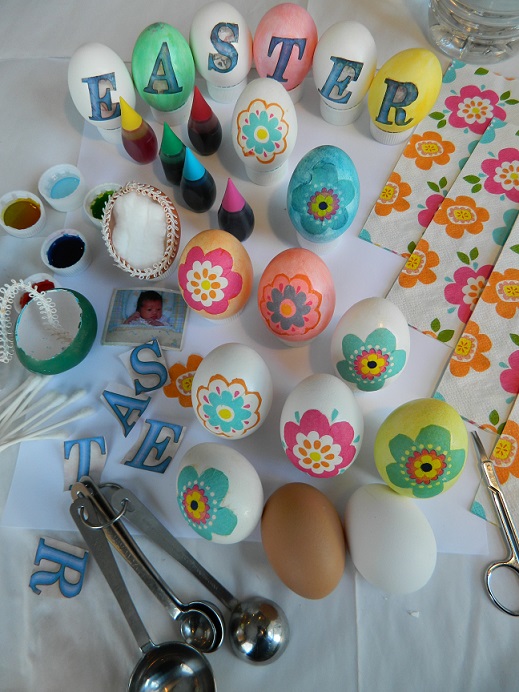 Easter eggs decoupage: designs cut from assorted papers are held in place by egg white for a non-toxic option. (Photos by Kimberly L. Jackson)Easter egg designs with decoupaged scrapbook paper cutouts and other materials are lovely, but if you glue on the designs with traditional decoupage medium, you can't eat the eggs. And the hollow shells of eggs drained out through holes are far too fragile for the Easter egg hunt.
Easter eggs decoupage: designs cut from assorted papers are held in place by egg white for a non-toxic option. (Photos by Kimberly L. Jackson)Easter egg designs with decoupaged scrapbook paper cutouts and other materials are lovely, but if you glue on the designs with traditional decoupage medium, you can't eat the eggs. And the hollow shells of eggs drained out through holes are far too fragile for the Easter egg hunt.
Planning for this Easter Sunday on April 5, we drained a lot of eggs to test various methods, and it made me remember that my mother had used egg white as emergency glue when I was a child. I decided to see if it would work to stick cutouts from newspapers and napkins to eggs. It worked on boiled eggs, emptied egg shells, plain egg shells and shells that had been "painted" using McCormick's super easy food color and vinegar paint.
Egg-white Glue for Non-toxic Easter Egg Decoupage: Crack open an egg and separate the yolk from the white (refrigerate the yolk for another use), placing the white in a shallow bowl. Add 1 teaspoon of water and whisk gently.
Materials for Non-toxic Easter Egg Decoupage: To be sure the dyes are non-toxic for eggs that will be eaten, cut out patterns from paper table napkins (the napkins shown are from Dollar Tree). If the eggs will be used for decoration, patterns can be cut from newspaper, scrapbook paper or magazines.
Color for Non-toxic Easter Egg Decoupage: If you want color, the hands down easiest technique is to mix a drop or two of McCormick food color in a tablespoon of vinegar. We had eight color options working with the traditional "Assorted" colors and fun "Neon!" colors. The color drops also can be mixed if you need even more options. We used caps from seltzer bottles both to mix the egg colors and as stands for the eggs to dry on.
Three-step instructions
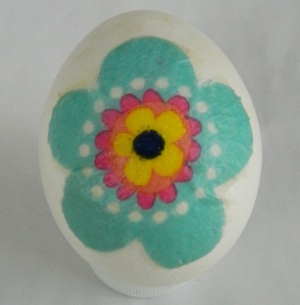 The egg-white decoupage technique works on plain and colored eggs.
The egg-white decoupage technique works on plain and colored eggs.
1. Use cotton swabs to dab paint evenly over egg shells if color is desired. Two coats may be needed for some colors. Let shells dry fully.
2. Place selected cutout design into the bowl with egg white glue. To avoid curling, avoid fully soaking napkins. Newspaper, magazine or scrapbook cutouts should be soaked through for easier smoothing.
3. Carefully place the cutout as desired on the egg shell, and smooth in place gently. Let egg designs dry fully on bottle caps. In our testing, the designs were still in place a full month after having been applied. (April 10, 2023 update: all the paper designs we tested are still in place and have not cracked or yellowed.)
Egg-shell diorama frame: Gently crack the center of a raw egg. Pick away pieces and then use nail scissors to carefully cut an oval-shaped opening. Wash the inside of the shell with soapy water and let dry fully. Paint the egg shell as in Step 1 above. Let dry.
Use white craft glue to adhere trim around the cut opening. Fill the inside of the shell with cotton balls (as shown on the above photo's left side at center). Trim a wallet-size photo slightly larger than the opening. Bend at sides and tuck into the egg shell for a fun Easter photo frame.
Glue a loop to the top of each egg, and they can be hung. Try painting a cluster of bare branches white then hang several of the eggshell frames from them to make a whimsical Easter tree decoration.
 Thursday, February 27, 2020 at 10:09PM
Thursday, February 27, 2020 at 10:09PM 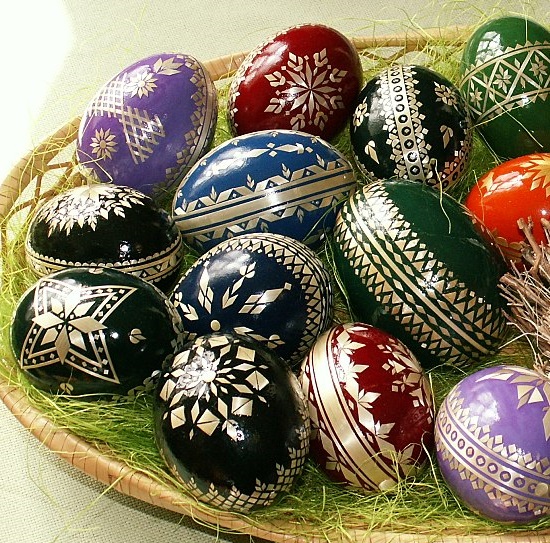 A collection of eggs decorated with straw. Photo by Jan KameníčekMarcela Hrabovská is an expert from the Czech Republic in traditional egg decorating with straw.
A collection of eggs decorated with straw. Photo by Jan KameníčekMarcela Hrabovská is an expert from the Czech Republic in traditional egg decorating with straw.
